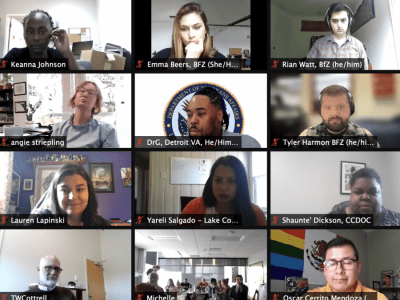When John Giles became mayor of Mesa, Arizona, six years ago, he knew homelessness was a serious problem.
“Now I say that homelessness is the issue in our community,” he said.
Mayor Giles was one of the more than 50 mayors and staff who participated in the Cities Built for Zero Homelessness virtual event on Feb. 10, hosted by Mayors and CEOs for U.S. Housing Investment and Community Solutions. The event brought together municipal and private sector leaders committed to solving homelessness.
Mayors and CEOs for U.S. Housing Investment is a national organization that brings top elected city officials and diverse business leaders together to highlight housing issues, oppose funding cuts, and advocate for critical tools to support affordable housing and address homelessness.
Mayors have a critical role to play — and they don’t have to figure this out on their own. Built for Zero equips cities to create an operating system for ending homelessness. Mayors from Mesa, Arizona, and Bakersfield, California, shared their communities’ journeys on the path to ending homelessness as part of Built for Zero.
Mesa, Arizona
As co-chair of Mayors and CEOs for U.S. Housing Investment and a mayor of a Built for Zero community, Mesa Mayor John Giles shared how Maricopa County is using Built for Zero’s data-driven approach to end veteran homelessness.
Maricopa County participated in Community Solutions’ 100,000 Homes Campaign in 2013 and was one of the first communities to join the Built for Zero movement in 2o15.
While the city of Phoenix had a robust program to address veteran homelessness, Mesa and the surrounding communities realized that a regional approach was needed to drive measurable reductions in homelessness.
Mayor Giles emphasized how the Built for Zero data-driven approach transformed how they approach ending homelessness and has been particularly useful during this current pandemic.
With their data, Mayor Giles and the Maricopa team discovered that the Centers for Disease Control and Prevention’s (CDC) eviction moratorium had an incredible impact on inflow, the number of veterans entering homelessness, and that fewer veterans were losing their homes because they could not be evicted.
Additionally, Mayor Giles realized that he had a critical role to play in recruiting landlords to participate in the Veterans Affairs Supportive Housing (HUD-VASH) program and helping landlords realize the importance of participating in these programs.
“By using data, we can better understand our communities’ needs and priorities. The data makes more clear what’s working, what’s not working, and what resources are needed. This data is particularly useful for mayors to identify data trends and how we can be cheerleaders and advocates.”
Since 2017, Maricopa County has reduced veteran homelessness by 15%.
Mayor Giles encouraged other mayors to embrace the Built for Zero methodology, “I hope you were somewhat envious when you saw what great data we have to make decisions about homelessness.”
Bakersfield, California
The impact of homelessness across California is no secret. And Kern County, which includes Bakersfield, realized they needed a different approach to drive measurable reductions in homelessness, beginning with a focus on those experiencing chronic homelessness. In January 2021, Kern County/Bakersfield announced they reached functional zero for this vulnerable population.
Kern County joined the Built for Zero movement in 2016, and the community used the opportunity to reimagine its homeless response system. As Mayor Goh recounted, “We witnessed homelessness gradually increasing across our county. We knew that we would have to find outside-the-box solutions to address this growing issue and we needed to find alternative solutions.“
After building its quality, by-name list, Kern County homeless response organizations focused on improving its system and testing ideas. Key actions that worked included:
- All organizations using the same definition of chronic homelessness
- Meaningfully educating and engaging landlords and securing commitments
- Revamping their case conferencing process that focused on collaborating and sharing information across the homeless response system
In closing, Mayor Goh reminded mayors of their influential role, “When we call people to join us, they will. When we talk, people listen. That is our role. It’s to make sure that everyone in our community understands that each of us has a role to play in ending homelessness.”
Public and Private Sector Join Forces
Ending homelessness is a community effort that also includes businesses and the private sector. As a health care company, Kaiser Permanente has seen the impact of homelessness on the health outcomes of their patients and throughout the health care system.
“You cannot have good health without having a reliable roof over your head. That’s why we’ve been supporting data-driven efforts to end homelessness like Built for Zero,” said Tony Barrueta, Senior Vice President for Government Relations for Kaiser Permanente, as he shared why their company is putting resources behind the Built for Zero movement as a core partner of Built for Zero.
In 2019, Kaiser Permanente joined the Built for Zero movement as a core partner and began an ambitious partnership with Community Solutions to support ending chronic and veteran homelessness in communities in our shared footprint across the United States.
As of 2020, 25 communities in which Kaiser Permanente operates are working with Built for Zero. In seven states and the District of Columbia, Kaiser Permanente community health professionals work directly with the Built for Zero movement to identify and leverage resources and opportunities to make meaningful reductions in homelessness.
How Elected Officials Can Support Built for Zero
Already a Built for Zero Mayor?
Elected officials’ support of Built for Zero community partners is critical to their success. You can help ensure your homeless response leaders have the resources, tools, and support to remove barriers and clear pathways to make homelessness rare, brief, and non-occurring.
- We can connect you to your local community leads so you can learn more about Built for Zero in your community and how you can play an active role in ending homelessness.
Interested in Built for Zero? Want to Learn More?
Getting to zero will take the commitment and coordination of multiple community partners and sectors. We can help you assess if your community is ready to be part of this exciting movement to end homelessness. Contact us and we’ll discuss these questions:
- Do you have the right people on board? To ensure your success, make sure you have the support and involvement of these key stakeholders.
- Do you understand your technology needs and challenges? Joining the Built for Zero Collaborative involves learning new ways to collect and use data to end chronic and/or veteran homelessness. Understanding your community’s data infrastructure is key.
- Is there community and political will? Community support is critical to making progress towards ending homelessness. You should assess where you feel you already have most of your key stakeholders on board, and where you’ll need to do some will-building.








